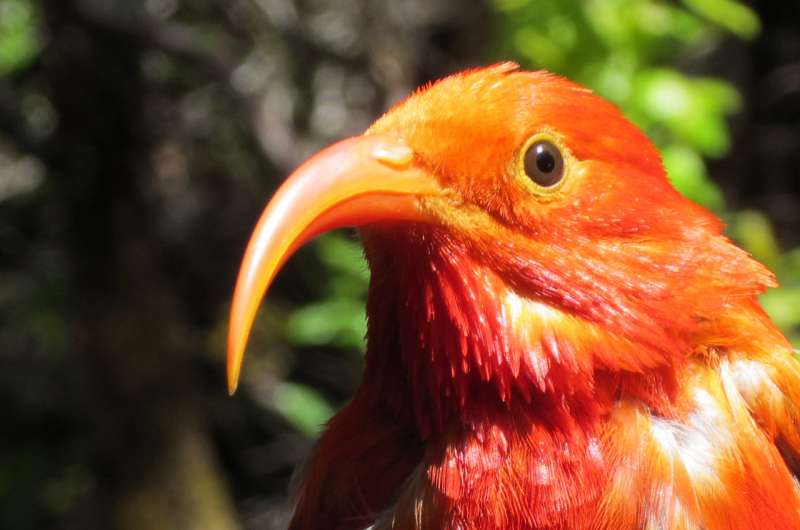Life cycle changes, such as breeding and molting, along with overall species abundance were found to shift in native Hawaiian birds, such as the 'i'iwi, to coincide with climate-related changes to native vegetation. Credit: US Forest Service/Amanda Uowolo
"You are what you eat" might give way to "you are when you eat," based on a new study tracking shifts in Hawaiian bird abundance, breeding and molting based on climate-related changes to native vegetation.
Researchers with the U.S. Forest Service's Pacific Southwest Research Station recently reviewed extensive climate, vegetation and bird data collected between 1976 and 1982 at a 40-acre monitoring site about 5 miles outside Hawai'i Volcanoes National Park on Hawai'i Island. Their results, "Bottom-up processes influence the demography and life-cycle phenology of Hawaiian bird communities," were recently published in this month's issue of Ecology and has implications for future bird population stability in future projected climates.
"The susceptibility of many Hawaiian birds to climatically-induced changes in their food web is alarming when considering that the archipelago has been subject to an increasingly drier climate during the last 30 years," said Jared Wolfe, a research ecologist and lead author of the study.
Wolfe, along with collaborators C. John Ralph and Andrew Wiegardt, found that three native birds that commonly feed on nectar—'i'iwi, 'apapane and Hawai'i 'amakihi—all timed their breeding season with the availability of 'ōhi'a lehua flowers, which in turn was coincident with periods of heavier rains. Similar correlations were found in select native and non-native bird species, based on their respective flower or fruit food sources and the timing of molting, an energy-taxing period when birds replace their feathers. Bird species abundance and scarcity also regularly mirrored the availability of their food sources.
"Our results suggest that changes in climate can cascade up the food chain and strongly affect wildlife at higher levels in the chain," Wolfe said.
The relative isolation in which Hawaiian ecosystems developed made it an ideal landscape to study the interaction between native birds and plants, avoiding other factors or influences that might mask climate effects in mainland populations. The inclusion of non-native bird species in the study also helped confirm that patterns detected were irrespective of evolutionary history.
"These types of studies are rare because they depend on long-term data and labor-intensive field work," said Ralph, an emeritus research ornithologist with the Pacific Southwest Research Station. "But findings from long-term studies, such as this one, are critically important because they provide insights into how changes in climate might affect organisms in seemingly indirect ways."
More information: Jared D. Wolfe et al, Bottom-up processes influence the demography and life-cycle phenology of Hawaiian bird communities, Ecology (2017). DOI: 10.1002/ecy.1981
Journal information: Ecology
Provided by USDA Forest Service





















